-
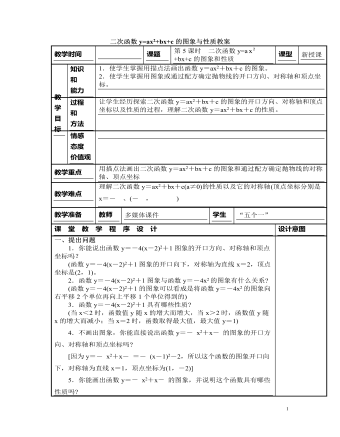
北师大初中九年级数学下册二次函数y=ax2+bx+c的图象与性质2教案
1.使学生掌握用描点法画出函数y=ax2+bx+c的图象。2.使学生掌握用图象或通过配方确定抛物线的开口方向、对称轴和顶点坐标。让学生经历探索二次函数y=ax2+bx+c的图象的开口方向、对称轴和顶点坐标以及性质的过程,理解二次函数y=ax2+bx+c的性质。用描点法画出二次函数y=ax2+bx+c的图象和通过配方确定抛物线的对称轴、顶点坐标理解二次函数y=ax2+bx+c(a≠0)的性质以及它的对称轴(顶点坐标分别是x=-b2a、(-b2a,4ac-b24a)一、提出问题1.你能说出函数y=-4(x-2)2+1图象的开口方向、对称轴和顶点坐标吗?(函数y=-4(x-2)2+1图象的开口向下,对称轴为直线x=2,顶点坐标是(2,1)。2.函数y=-4(x-2)2+1图象与函数y=-4x2的图象有什么关系?(函数y=-4(x-2)2+1的图象可以看成是将函数y=-4x2的图象向右平移2个单位再向上平移1个单位得到的)

北师大初中九年级数学下册二次函数y=x2和y=-x2的图象与性质2教案
【教学目标】(一)教学知识点能够利用描点法作出函数 的图象,并根据图象认识和理解二次函数 的性质;比较两者的异同.(二)能力训练要求:经历探索二次函数 图象的作法和性质的过程,获得利用图象研究函数性质的经验.(三)情感态度与价值观:通过学生自己的探索活动,达到对抛物线自身特点的认识和对二次函数性质的理解. 【重、难点】重点 :会画y=ax2的图象,理解其性质。难点:描点法画y=ax2的图象,体会数与形的相互联系。 【导学流程】 一、自主预习(用时15分钟)1.创设教学情境我们在教学了正比例函数、一次函数、反比例函数的定义后,都借助图像研究了它们的性质.而上节课我们所学的二次函数的图象是什么呢?本节课我们将从最简单的二次函数y=x2入手去研究

北师大初中九年级数学下册二次函数y=a(x-h)2+k的图象与性质1教案
(3)设点A的坐标为(m,0),则点B的坐标为(12-m,0),点C的坐标为(12-m,-16m2+2m),点D的坐标为(m,-16m2+2m).∴“支撑架”总长AD+DC+CB=(-16m2+2m)+(12-2m)+(-16m2+2m)=-13m2+2m+12=-13(m-3)2+15.∵此二次函数的图象开口向下,∴当m=3米时,“支撑架”的总长有最大值为15米.方法总结:解决本题的关键是根据图形特点选取一个合适的参数表示它们,得出关系式后运用函数性质来解.三、板书设计二次函数y=a(x-h)2+k的图象与性质1.二次函数y=a(x-h)2+k的图象与性质2.二次函数y=a(x-h)2+k的图象与y=ax2的图象的关系3.二次函数y=a(x-h)2+k的应用要使课堂真正成为学生展示自我的舞台,还学生课堂学习的主体地位,教师要把激发学生学习热情和提高学生学习能力放在教学首位,为学生提供展示自己聪明才智的机会,使课堂真正成为学生展示自我的舞台.充分利用合作交流的形式,能使教师发现学生分析问题、解决问题的独到见解以及思维的误区,以便指导今后的教学.
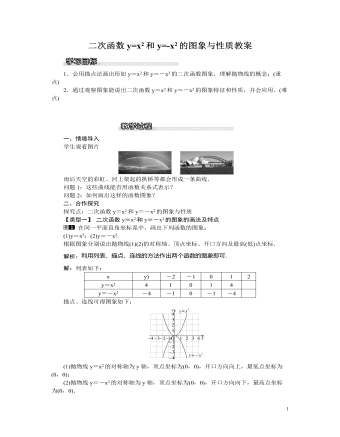
北师大初中九年级数学下册二次函数y=x2和y=-x2的图象与性质1教案
雨后天空的彩虹、河上架起的拱桥等都会形成一条曲线.问题1:这些曲线能否用函数关系式表示?问题2:如何画出这样的函数图象?二、合作探究探究点:二次函数y=x2和y=-x2的图象与性质【类型一】 二次函数y=x2和y=-x2的图象的画法及特点在同一平面直角坐标系中,画出下列函数的图象:(1)y=x2;(2)y=-x2.根据图象分别说出抛物线(1)(2)的对称轴、顶点坐标、开口方向及最高(低)点坐标.解析:利用列表、描点、连线的方法作出两个函数的图象即可.解:列表如下:x y) -2 -1 0 1 2y=x2 4 1 0 1 4 y=-x2 -4 -1 0 -1 -4 描点、连线可得图象如下:(1)抛物线y=x2的对称轴为y轴,顶点坐标为(0,0),开口方向向上,最低点坐标为(0,0);(2)抛物线y=-x2的对称轴为y轴,顶点坐标为(0,0),开口方向向下,最高点坐标为(0,0).方法总结:画抛物线y=x2和y=-x2的图象时,还可以根据它的对称性,先用描点法描出抛物线的一侧,再利用对称性画另一侧.
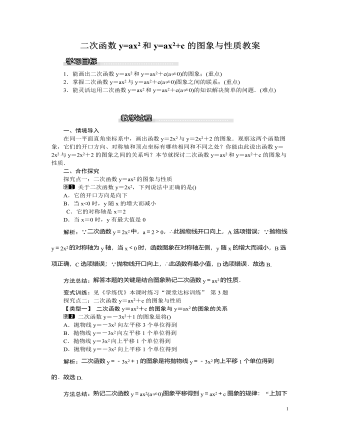
北师大初中九年级数学下册二次函数y=ax2和y=ax2+c的图象与性质1教案
变式训练:见《学练优》本课时练习“课堂达标训练”第5题【类型二】 在同一坐标系中判断二次函数和一次函数的图象在同一直角坐标系中,一次函数y=ax+c和二次函数y=ax2+c的图象大致为()解析:∵一次函数和二次函数都经过y轴上的点(0,c),∴两个函数图象交于y轴上的同一点,故B选项错误;当a>0时,二次函数的图象开口向上,一次函数的图象从左向右上升,故C选项错误;当a<0时,二次函数的图象开口向下,一次函数的图象从左向右下降,故A选项错误,D选项正确.故选D.方法总结:熟记一次函数y=kx+b在不同情况下所在的象限,以及熟练掌握二次函数的有关性质(开口方向、对称轴、顶点坐标等)是解决问题的关键.变式训练:见《学练优》本课时练习“课后巩固提升” 第4题【类型三】 二次函数y=ax2+c的图象与三角形的综合
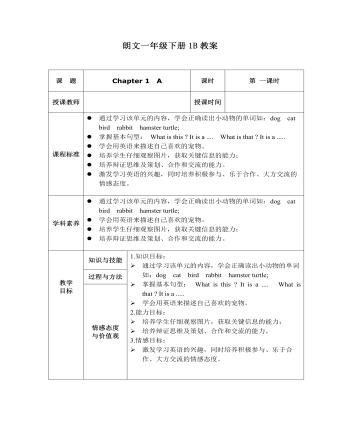
一年级朗文下册1B 教材 Chapter 1 A
l 通过学习该单元的内容,学会正确读出小动物的单词如:dog cat bird rabbit hamster turtle;l 掌握基本句型: What is this ? It is a .... What isthat ? It is a .....l 学会用英语来描述自己喜欢的宠物。l 培养学生仔细观察图片,获取关键信息的能力;l 培养辩证思维及策划、合作和交流的能力。l 激发学习英语的兴趣,同时培养积极参与、乐于合作、大方交流的情感态度。
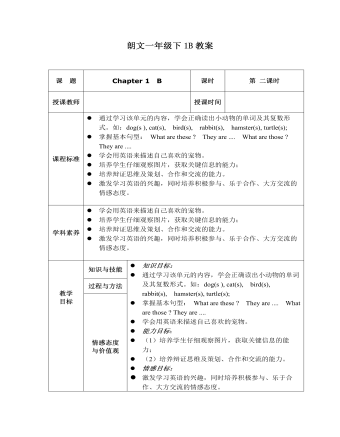
一年级朗文教材下册1B Chapter 1 B
l 通过学习该单元的内容,学会正确读出小动物的单词及其复数形式。如:dog(s ), cat(s), bird(s), rabbit(s), hamster(s), turtle(s);l 掌握基本句型: What are these ? They are .... What are those ? They are ....l 学会用英语来描述自己喜欢的宠物。l 培养学生仔细观察图片,获取关键信息的能力;l 培养辩证思维及策划、合作和交流的能力。l 激发学习英语的兴趣,同时培养积极参与、乐于合作、大方交流的情感态度。

人教部编版道德与法制二年级上册这些是大家的说课稿
2、儿歌总结。我们想出了这么多的爱护公物的好办法,王老师把他们都藏在儿歌里了,一起念念吧。爱护公物我能行小朋友,讲文明,爱护公物我能行。不在桌上乱刻画,挪动桌椅要小心。卫生用具要爱惜,开门开窗手脚轻。雪白墙壁不留痕,对待花木有爱心。学校图书我爱护,损坏及时来修补。路遇破坏会制止,劝说他人有耐心。体育器材都爱护,爱护公物我能行!我能行!小结:爱护公物我能行,不单单是一句口号,更要落实在我们的实际行动中3、课后小小约定:(课件出示班级公约)爱护公物需要一份关爱,一份呵护,更需要一份约定。相信我们班的孩子一定能在约定中开出爱护之花,因为我们知道,公物是大家的,需要我们一起爱护她。4、课后整理:学生轻轻整理学习用品,轻轻摆放桌椅,安静有序离开教室。
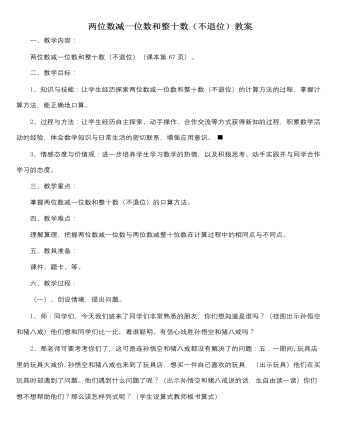
人教版新课标小学数学一年级下册两位数减一位数和整十数(不退位)教案
一、教学内容:两位数减一位数和整十数(不退位)(课本第67页)。二、教学目标:1、知识与技能:让学生经历探索两位数减一位数和整十数(不退位)的计算方法的过程,掌握计算方法,能正确地口算。2、过程与方法:让学生经历自主探索、动手操作、合作交流等方式获得新知的过程,积累数学活动的经验,体会数学知识与日常生活的密切联系,增强应用意识。3、情感态度与价值观:进一步培养学生学习数学的热情,以及积极思考、动手实践并与同学合作学习的态度。三、教学重点:掌握两位数减一位数和整十数(不退位)的口算方法。四、教学难点:理解算理,把握两位数减一位数与两位数减整十位数在计算过程中的相同点与不同点。五、教具准备:课件、题卡、等。六、教学过程:(一)、创设情境,提出问题。
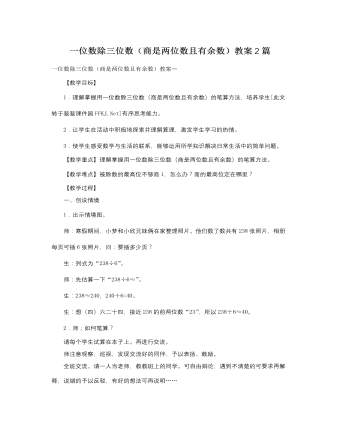
人教版新课标小学数学三年级下册一位数除三位数(商是两位数且有余数)教案2篇
二、互动交流,理解算法1.出示教科书第22页的情境图,提问:他们在干什么?你获得了什么信息?能提出什么问题?怎样列式?2.师:今天我们就学习一位数除三位数的计算方法。(板书课题:一位数除三位数)3.师:怎样计算238÷6呢?你能用估算的方法估计出大致结果吗?4.学生尝试独立完成例3的竖式计算。师:在这道题中被除数最高位上是2个百,2个百除以6,商不够1个百怎么办?师:谁能说一说商3个十的3写在商的什么位置上?为什么?教师边板演边说明:用除数6去乘3个十,积是18个十,表示被除数中已经分掉的数,写在23的下面。23减18得5,表示十位上还剩5个十。师:接下来该怎么办?(把被除数个位上的8落下来,与十位上的5合起来继续除。)师:最后结果是多少?5.启发学生想一想:如果一本相册有24页,一本相册能插得下这些照片吗?2本呢?

初中历史与社会人教版九年级下册《地球一小时 活动》教材教案
地球一小时(Earth Hour)是世界自然基金会(WWF)应对全球气候变化所提出的一项倡议,希望家庭及商界用户关上不必要的电灯及耗电产品一小时。来表明他们对应对气候变化行动的支持。过量二氧化碳排放导致的气候变化目前已经极大地威胁到地球上人类的生存。公众只有通过改变全球民众对于二氧化碳排放的态度,才能减轻这一威胁对世界造成的影响。地球一小时在3月的最后一个星期六20:30~21:30期间熄灯。活动由来:“地球1小时”也称“关灯一小时”,是世界自然基金会在2007年向全球发出的一项倡议:呼吁个人、社区、企业和政府在每年三月最后一个星期六20:30~21:30期间熄灯1小时,以此来激发人们对保护地球的责任感,以及对气候变化等环境问题的思考,表明对全球共同抵御气候变暖行动的支持。这是一项全球性的活动,世界自然基金会于2007年首次在悉尼倡导之后,以惊人的速度席卷全球,大家都来参加这个活动。[1] “地球1小时”活动首次于2007年3月31日在澳大利亚的悉尼展开,一下子吸引了超过220万悉尼家庭和企业参加;随后,该活动以惊人的速度迅速席卷全球。在2008年,WWF(中国)对外联络处透露,全球已经有超过80个国家、大约1000座城市加入活动。2013年,包括悉尼歌剧院、帝国大厦、东京塔、迪拜塔、白金汉宫在内的各国标志性建筑也在当地时间晚八点半熄灯一小时。[2] ,其中包括巴勒斯坦、法属圭亚那、加拉帕戈斯群岛、卢旺达、圣赫勒那岛、苏里南、突尼斯等首次参与“地球一小时”的国家和地区。在中国,北京鸟巢、水立方、世贸天阶等标志性建筑同时熄灯,同一时段,从上海东方明珠到武汉黄鹤楼,从台北101到香港天际100观景台,中国各地多个标志性建筑均熄灯一小时,全国共有127个城市加入“地球一小时”活动。

人教版新目标初中英语七年级下册How was your weekend教案2篇
Teaching Goal:1. General aims:Talk about recent past events2. Particular aims:A. Language Focus.Talk about recent past events and think of the past events.B. Language goalsHow was….?It was …What did …do over the weekend?C. Language structures:(1). How was your weekend? I was great. Pay attention to no form.(2). What did you do over the weekend? I played soccer. We went to the beach.D. Useful words and phrases:Words: was, did, went, beach, over, project, test, wasn’t, false, number, geography, spend, week, most, mixture, their, had, little, cook, read, saw, change, everyone, sit, sat, no, anythingPhrases: did one’s homework, played soccer, cleaned my room, went to the beach, played tennis, went to the movies, on Saturday morning, over the weekend, cook … for, what about, do some reading, have a party, talk show, go shoppingE. Grammar language:Present simple past tenseRegular and irregular verbsF. Learning strategies:Tour and holidaysG. Interdiscipinary:H. Emotion and manner:Teaching time: 5 periodsTeaching procedures:Period One教学步骤、时间 教师活动 学生活动 媒体应用Step 1Free talk 3’ Ask some questions like:Who’s on duty today?What’s the weather like? Answer and talk about something.让同学们回答下列问题1. Do you like weekend? (Let some students answer)It takes them three minutes to talk about the question.2. Why do you like weekend? (let the students answer) Most of the students like the weekend此时教师用汉语问:“在周末期间问你干了什么?这句话用英语这么回答?Let the students guess.At last the teacher give them right answer3. What did you do over the weekend?(板书、学习)

人教版新目标初中英语七年级下册What does he look like教案3篇
所需要用到的句子:Who is that?That is Jack. I like him.Why do you like him?I like him because he is interesting.Task 4: 设计理想中的人类Step one: 设计理想中的人类的外貌。把全班同学分成若干小组,学生可以边说边在纸上画出他们的模样。Step two: 设计理想中人类的性格。学生们可以把那些能描述性格的单词写在图画的旁边。Step three: 每组选出一名同学,其他同组同学提问,他作简单回答,并说明原因。所需用到的句子:What does he or she look like?He or she ...What is he or she like?He or she is ...Why?Because ...Task 5: 挑战性活动调查性格是天生的还是后天形成的,让每个同学回家去调查一下自己成长过程中性格是否有变化,具体是怎样的,为什么会这样? Teaching Aims:1. Enable students to have a general understanding of how to talk about people's physical appearance.2. Enable students to tackle some essential vocabularies and patterns about describing people. Provide them with necessary skills and methods.3. Create various chances for students to describe the persons they're familiar with, such as classmates, family members, teachers, idols, etc.

人教版新目标初中英语七年级下册Where is the post office教案2篇
Period 2 (3a----Section B 2c)Preview(Pre-task): Key points: What laAdd another information about their pen pals----their language on the cardnguage does she/he speak?She/He speaks....Does she/he have any brothers and sisters? Does she/he speak English?Preview(Pre-task): Add another information about their pen pals----their language on the cardKey points: What language does she/he speak?She/He speaks....Does she/he have any brothers and sisters? Does she/he speak English?Step 1 Revision1.Revisionand dictation of the new words 2.Revise the drills they learned yesterday.(by pairwork and grammar exercise)Step 2 Leading-inT has a conversation with one student. The conversation is following:---Do you have a pen pal?---Yes, I do.---What's your pen pal's name? ---His/Her name is....---Where is your pen pal from? ---He/She is from...---Where does he/she live? ---He/She lives in....---What language does he/she speak?He/She speaks...Write the new words on the Bb. They are following: EnglishChineseJapaneseFrenchStep 3 LearnLearn the new words with the whole class.Finish 3a with the students3b Pairwork T still does an example with one student Then the Ss practise in pairs. The example is following:--Curry Muray is my pen pal. He is from the United States.---What language does he speak?

人教版新目标初中英语七年级下册Don’t eat in class教案2篇
Don’t fight. =You can’t fight. (板书,教读)教师把这些句子板书在黑板上,并请学生大声整齐地读祈使句和“can’t”句型,并让学生注意两种句型表达形式的不同和转换,“Don’t …=You can’t…”;并对学生说:These are our school rules. (板书,教读) You can’t break the school rules. Don’t break the school rules.(板书,教读)步骤3 :Practicea. T: Now, each of the students is breaking one of these rules.Please finish 1a.学生看图,完成1a的内容,检查答案并大声朗读校规。b. 听录音,完成1b,选出四位学生都违反了哪条校规;听之前,学生要读会英文名。c. 请两位学生朗读1c部分的句型;要求学生两人一组对话表演,SA扮演外校转来新生,SB告知本校校规。(学生可经过讨论,多说出他们想到的校规,不必只限于书上;教师应给予帮助)2) 第二课时(2a~4)步骤1 :warming up of revisionT: What are the rules at your school?学生使用“can”或祈使句表达各条校规;其中老师可引出“eat in the cafeteria outside”的表达。步骤2 :Practicea.T: Christina is an exchange student. She doesn’t know the rules. Let’s listen, what activities they’re talking about?学生听第一遍时,完成2a;第二遍时,完成2b;b. 请学生领读2c部分,看着2a完成的表格,理解2c活动的要求;分成小组针对2a进行问答;

人教版新目标初中英语七年级下册I ’d like some noodles教案
教学过程Step 1: warming-up Sing a song---------“food and drink” Step 2: Revision1 Dictation2 Revise: What kind of noodles would you like?I’d like …What size bowl of noodles would you like?I’d like…Step 3: Presentation1 show pictures of food, ask students say the words.2 Students read the newspaper ad in 3a. Fill in blanks with words in the box. Then read the ad together, the teacher explains some difficult language points.3 Check the answers Step 4 PracticeAsk students to finish 3b in the same way according to 3a. Students read the short passage and fill in the blanks .At last, check the answers.Step 5 productionAsk students to write their own ad for dumplings, noodles, drinks, and other foods they know. Then ask students to read their partner’s ad. Then order food and drink from their partner.Step 6 Home workGroup work – make an ad about “food and drink”

人教版新目标初中英语七年级下册I want to be an actor教案2篇
三、教学建议第一课时:1. Lead in (Vocabulary)A) Before class, teacher should collect some pictures of working places. For example: Bank, TV Station, Restaurant, Police Station, Hospital ...B) In class, show students the pictures (PowerPoint, OHP). Ask students to tell the name of the working places and the name of the jobs.Shop assistant, doctor, actor, reporter, police office, waiter, bank clerk, studentC) Do exercise 1a and 3a.2. Bingo GameAsk groups of students to make up pairs of cards with a job on one and the related workplace on the other. For example, waiter / restaurant, teacher / school, doctor / hospital. Encourage students to use both the job / workplace combinations in the book and the ones that students came up during class discussions. Be sure they have twice as many sets of cards as there are students in the group. They can make two sets of cards for a single job / workplace, if necessary. Then have each group mix up its set of cards and hand their cards out in random order. Each time a student gets a pair of cards that match, he or she can lay these cards down. The goal is to have no cards in your hand at the end.3. Task OneA) Ask students to work in pairs and ask the partner what does he / she want to be in the future.e. g. :What do you / does he / does she want to be?I want to be a.Why?Because it's (adj).B) Vocabulary: Section B, 1a4. Homework 1.2.

人教版新目标初中英语七年级下册It’s raining教案2篇
1 Each group choose one place to describe and what you are doing in it Choose one place, and describe what they are doing 2 Move around the room and give suggestions Talk about it and write it down 3 Ask one to show their works and act it Choose one of each group to make a report 4 Evaluate the best group and the best reporter Choose the best one Homework Ask your friends their ideal place and write about it教学反思:新课程标准中强调学生在课堂中的主体地位,在综合课中他们的主体地位就更加突出。在各个活动中给不同程度的学生不同层次的任务,让各层面的学生都有表现发挥的机会,从而产生对英语的兴趣。使用照片图片多媒体来辅助教学,效果更好。同时让了解其他国家风景,风俗的同学介绍ideal place,增加学生的背景知知识,实现跨学科交流的目的。教案点评:采用任务型教学模式,在各个活动中给不同程度的学生不同层次的任务,让各层面的学生都有表现发挥的机会,从而产生对英语的兴趣。使用照片图片多媒体来辅助教学,效果更好。让了解其他国家风景,风俗的同学介绍ideal place,增加学生的背景知识,实现跨学科交流的目的。

人教版新目标初中英语七年级下册Where is your pen pal from教案
2.1Match the country with the language.Step II Reading3a? let the students read the letter fast and answer the questions.? Let the students ask more questions about the letter as possible as the can.Step III Writing3b.Step IV. Pairwork2cStep V Listening2a, 2bStep V. HomeworkExercises book(1) P3Exercises book (2) P3Period FourStep I . Dictate the words and sentences in Unit1.Step II. Self-checkStep III. Check the answers for Exercises book in the unit.Step IV. Home workRevise and preparation for unit 2.教学反思:通过本单元的学习,学生基本可以谈论人们的国籍,居住城市及其所说的语言,通过书信方式去介绍自己并寻找笔友。但在涉及到国外的一些城市时,学生对这方面的知识相对欠缺,能介绍的城市并不多,也反应出学生课前预习不充分,这跟学生学习条件也有关,大多数学生无法通过网络获取所需信息。因此,在以后的教学中要多指导学生通过计算机网络获取信息,拓宽知识面。

人教版新目标初中英语七年级下册What do you think of game shows教案
五、教学Section B-2c1. Pair work: What do you think of the belt/sunglasses/…? What does your father/mother/… think of your scarf/belt…?2. Group work(1). Teacher shows some different kinds of school uniforms (制服)and asks : “ What do you think of your school uniforms? If you have a chance to choose your school uniforms, what kind would you like to choose?”(2). Discuss in groups.(3).Get some Ss to report in class.说明:这一步旨在让学生运用已有的语言知识谈论对事物的看法和意见,并简单阐明理由,培养学生的主动思维能力和运用英语的能力。六、教学拓展调查电视节目的收视率任务:调查你周围的人对现在各种电视节目的反响。活动过程:1.教师布置任务,让学生调查周围的人(包括他的亲戚朋友和邻居)喜欢收看哪方面的电视节目。2.学生进行调查活动,运用本单元所学的句型What do you think of….? (Why?)What's your favorite game shows?What do you think of talk show?I doesn’t mind it.I like it.I love it.I can’t stand it.3.记录下排在前10位的TV Program,填写调查表,比较其收视率。